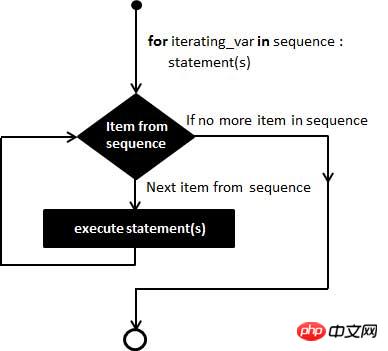
This chapter will introduce you to the use of Python loop statements. Loop statements in Python include for and while. The main content of this article is the for loop statement in python language, and the else loop mentioned will be listed separately for explanation.
Brief comment:
Loop statements are an integral part of any programming language. Similarly, for loop is an important part of Python
The following is the structure diagram of the for loop statement:

First of all, we can loop like this
fruits = ['apple', 'banana', 'mango']
for fruit in fruits:
print(fruit.capitalize())This is the basic structure of the for loop, now let us continue to discuss a little-known for loop in python Well-known properties - else clause.
The for loop also has an else clause that most people are not familiar with. This else clause is executed when the loop completes normally, meaning that the loop does not encounter any break statements. They are very useful when you understand where to use them.
A common situation is to run a loop and search for an item, and if the item is found, we use break to get out of the loop. There are two situations that may cause the loop to end. The first one is to find the item and break , the second case is the natural end of the loop. Now we might want to know which of these is the reason for the loop to complete, one way is to set a flag and then check it when the loop ends, another is to use the else clause.
The following is the basic structure of a for/else loop:
for item in container:
if search_something(item):
# Found it!
process(item)
breakelse:
# Didn't find anything..
not_found_in_container()The following example comes from the official documentation
for n in range(2, 10):
for x in range(2, n):
if n % x == 0:
print(n, 'equals', x, '*', n/x)
breakIt finds factors between 2 and 10. Now for the fun part, we can add an extra else clause block to capture prime numbers and print them:
for n in range(2, 10):
for x in range(2, n):
if n % x == 0:
print( n, 'equals', x, '*', n/x)
break
else:
# loop fell through without finding a factor
print(n, 'is a prime number')Extracurricular extension:
Python while loop statement explanation and synchronous parsing ( Code example)
The above is the detailed content of Python introductory loop: for loop and else usage, with detailed examples included. For more information, please follow other related articles on the PHP Chinese website!




